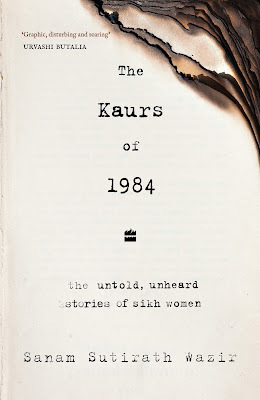Heart-breaking and disturbing

 Captions: Book cover; Author Sanam Sutirath Wazir
Captions: Book cover; Author Sanam Sutirath WazirSanamSutirath Wazir’s ‘The Kaurs of 1984 — the Untold, Unheard Stories of SikhWomen’ is a razor-sharp look at the extraordinary devastation that womensuffered after the assassination of Prime Minister Indira Gandhi in 1984
ByShevlin Sebastian
OnJune 4, 1984, Rachpal Singh, the secretary of militant leader Sant JarnailSingh Bhindranwale, was in a room in the Golden Temple. He was with his wifePritam and their 18-day-old son. The Army was shooting into the Temple duringOperation Bluestar.
Pritamsaid, “A flash of light would come in from the space below the doors and blindus for a few seconds, followed by the deafening sounds of bombs. I could hearthe sound of tank treads moving outside our room, proceeding towards the AkalTakht (the chief centre of religious authority among the Sikhs).”
At12.15 am on June 6, a bullet hit her baby’s back before hitting Pritam on thechest. As Rachpal bent over his wife and son, a bullet hit him on the head. Hedied instantly. Pritam lay in a pool of blood, with her dead husband beside herand her dead son lying on her chest.
ManjeetSingh, the then press secretary of the Akali Dal, saw a young man and hisinfant son killed. The mother picked up the son and placed him on his father’schest. “It’s been more than three decades now, but whenever I close my eyes,that scene comes back to me,” said Manjeet.
AuthorSanam Sutirath Wazir focuses on the suffering of Sikh women in the book, ‘TheKaurs of 1984 - the untold, unheard stories of Sikh women’. Many of whom wererape victims during the 1984 cataclysm that shook Punjab, and the riots thattook place in Delhi and other places.
TheSikh psyche was shattered because of the army’s widespread damage to the GoldenTemple. ‘Over 350 bullets riddled the dome of the Golden Temple,’ wrote Wazir.‘One bullet pierced the cushion on which the Guru Granth Sahib was placed,pushing through as many as eighty-two pages of the book itself. Most of theitems in the toshakhana (a storehouse for valuables) were destroyed….all thehandwritten hukamnamas (orders), penned by different Sikh gurus across theages, were lost as well.’
Wazirwrites with painstaking details about the damage to the Golden Temple and thehuman rights violations by the Army and the security agencies that took placethereafter. Even women and children were not spared.
Nosurprises, there was a blowback. On October 31, 1984, Prime Minister IndiraGandhi was shot dead by her Sikh guards, Beant Singh and Satwant Singh.Immediately, in Delhi, mobs, mainly orchestrated by the Congress Party, laidsiege to the Sikh community.
AtBlock 32 in Trilokpuri, East Delhi, local leader Rampal Saroj, accompanied by agroup of men, asked resident Darshan Kaur where her husband Ram Singh was. She saidhe had gone out with his brother.
Themen did not believe her. They broke down the main door and barged into thehouse. Ram Singh was hiding in the kitchen. ‘They dragged him out by his hair,’wrote Wazir. ‘They placed a quilt and tyre over his head, doused him in oil andthen set him ablaze. Ram Singh was nearly burnt to death; he later succumbed tohis injuries.’ In the end, all the Sikh men who were present in Block 32 onthat day were killed. There were 275 widows across 180 homes.
Themen committed rape against elderly, middle-aged women, and teenage girls.Darshan said a young girl of 15 returned, naked and bruised. She had been rapedmany times, by some as old as her grandfather.
Chapterby chapter Wazir tells harrowing tales about what happened to the Sikh women,in places like Sultanpuri, Raj Nagar and Mukherjee Nagar. Their lives weredestroyed. Very few have recovered. As one woman, Satwant Kaur, said, “Thosemonsters had scarred me for life.”
Astoundingly,many women recalled that the rioters used white powder on the victims. Wazirsaid that it could have been white phosphorus. The powder burns human flesh andcatches fire when exposed to the air.
Theviolence spread beyond Delhi. In Hondh Chillar, in the Rewari district inHaryana, a mass grave of Sikhs was discovered in 2010.
However,India has not stepped back from this destructive route. Since 1984, accordingto a Google search, there have been over 70 riots in different parts of India.The latest was the Haldwani riots in Uttarakhand on February 9, 2024.
Waziralso focuses on women who became militants and became part of pro-Khalistangroups as well as the lives of widows in refugee camps.
Thisbook is a very valuable document. It heightens awareness of the suffering thattakes place. Or as feminist publisher Urvashi Butalia said on the cover, thebook is ‘graphic, disturbing and searing.’
Weneed to read it, get appalled and vow to ourselves that as a people, we shouldnever allow such events to happen again.
(Anedited version was published in The Sunday Magazine, The New Indian Express,South India and Delhi)



